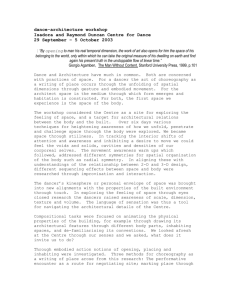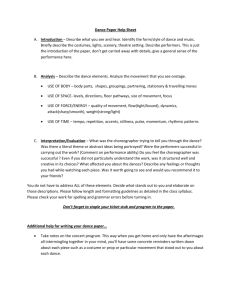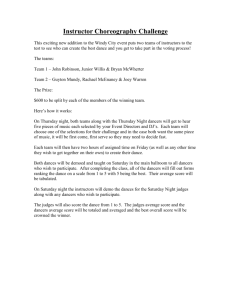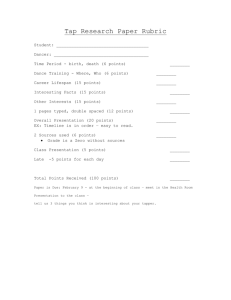Ashley Grable
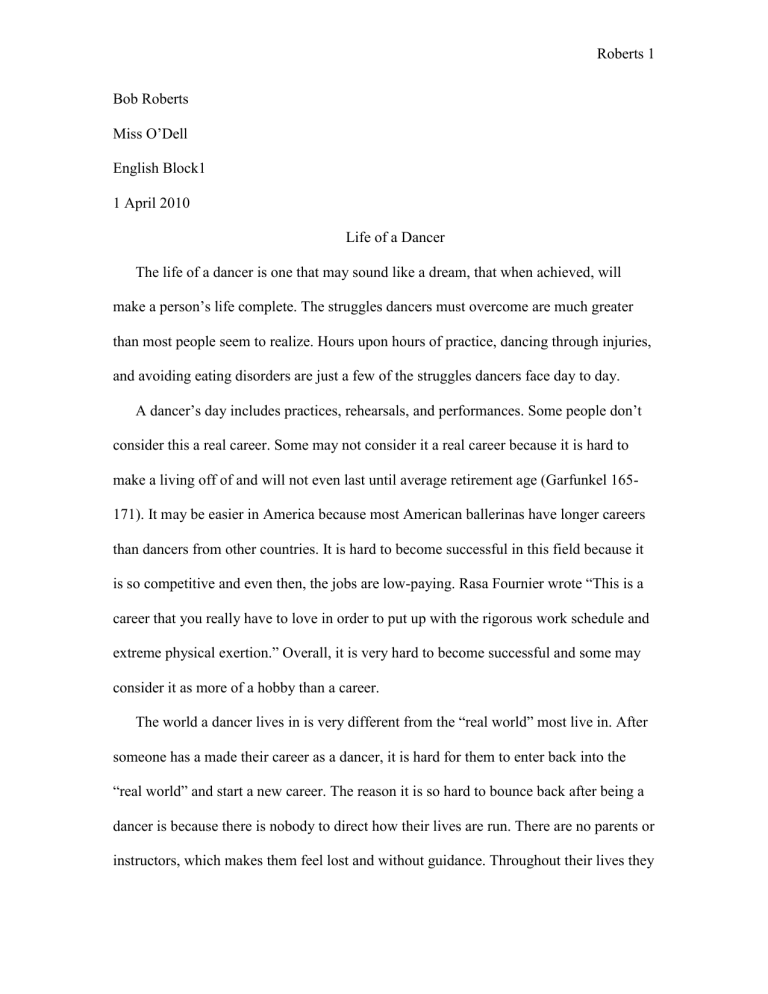
Roberts 1
Bob Roberts
Miss O’Dell
English Block1
1 April 2010
Life of a Dancer
The life of a dancer is one that may sound like a dream, that when achieved, will make a person’s life complete. The struggles dancers must overcome are much greater than most people seem to realize. Hours upon hours of practice, dancing through injuries, and avoiding eating disorders are just a few of the struggles dancers face day to day.
A dancer’s day includes practices, rehearsals, and performances. Some people don’t consider this a real career. Some may not consider it a real career because it is hard to make a living off of and will not even last until average retirement age (Garfunkel 165-
171). It may be easier in America because most American ballerinas have longer careers than dancers from other countries. It is hard to become successful in this field because it is so competitive and even then, the jobs are low-paying. Rasa Fournier wrote “This is a career that you really have to love in order to put up with the rigorous work schedule and extreme physical exertion.” Overall, it is very hard to become successful and some may consider it as more of a hobby than a career.
The world a dancer lives in is very different from the “real world” most live in. After someone has a made their career as a dancer, it is hard for them to enter back into the
“real world” and start a new career. The reason it is so hard to bounce back after being a dancer is because there is nobody to direct how their lives are run. There are no parents or instructors, which makes them feel lost and without guidance. Throughout their lives they
Roberts 2 have been told exactly what to do and how to do it, and once they leave the world of dance, this direction is gone. When a dancer joins a company, it is like joining a family.
When they leave the company, their family is gone (Gordon).
Mothers greatly influence their children as they become dancers. Many pressure their children to join dance because they once had dreams of being a dancer themselves.
Parents believe it will also give their child grace and focus. This will focus attention away from real life problems and keeps them in their own world. Their lives are dictated to them and they don’t know how to run their own lives. All this influence from parents makes it hard to enter into the real world once they are without their parents (Gordon 17).
During the 1960s-1970s the popularity of ballet had increased. Dance may have become increasingly popular during this time because the media tends to glorify the bad conditions of dancers (Garfunkel 161-162). Some even approach ballet as if it is another world, as if the dancers are not human beings. Although most encourage dancers to obtain a certain look, New York Times complimented dancers who were healthy. Even though the conditions are not nearly as great as the media makes them out to be, some still find the reward of being a dancer great. To become a dancer is like entering a world of peace. Doing what they love, performing, and being the best is enough of a reward to make them strive to make it in this career (Gordon 206).
The aesthetics of ballet cause much emotional and physical stress. One reason why the “look” for dancers may not be that of a normal female body is because many company owners and choreographers are gay. This may lead to their dislike of a feminine body causing them to look for other features. To obtain the “look” most want, a girl at a young age can be kept under a 17% body fat level. This stops menstruation, which causes
Roberts 3 low estrogen levels. Even though some say a ballet body is picked out, it generally doesn’t happen this way. But, using poor nutrition, you can create one. Trying to get the right body most are looking for causes eating disorders such as anorexia and bulimia.
This causes dancers to emotionally stress out about their physical imperfections. All the physical stress of getting the perfect body ends up causing emotional stress for many dancers (Gordon 153-155).
The health risks of ballet are very great. Some dancers will even risk their health to have the look of a dancer that choreographers crave. When ballerinas starve themselves to achieve a “ballet body”, the body will eat away at the muscles that aren’t working, which leaves the useful ones strong (Gordon 12, 157). When these eating problems develop, injuries are caused, which cause long term problems, which will cause them to lose strength (“Risks”). Most will dance through their injuries just so that they won’t lose their job. Along with the continuation of dancing, problems such as eating disorders will slow the healing process even more (Gordon 12, 155). The cause of these injuries includes lack of technique or executing moves incorrectly (“Risks”). Injuries and eating disorders are both huge health risks of becoming a dancer.
Dancers must give in to pressure from everyone around them otherwise, they might not become what a company is looking for. The pressure that dancers must succumb to includes that of their teachers, parents, audiences, choreographers, and other students.
These people tell them how imperfect they are and what they must do to change. Parents are always making sure that their kid is the best. Teachers tell the students how imperfect they are with every little move they make. Although parents and teachers are just trying
Roberts 4 to help them become what companies are looking for, sometimes the pressure becomes overwhelming (Gordon 26).
A dancer’s life is all about making sacrifices to achieve their goal. This requires personal sacrifice. This includes social and emotional sacrifices to achieve their goals.
According to Suzanne Gordan, “I have never come across such an unhappy group of people.” Dancers sometimes will sacrifice their happiness just to reach their dream of going up on a stage and performing the art they love. Financial sacrifices are also something that is expected. Dancers often earn less than the musicians and stagehands at their performances. All these sacrifices are just one more thing that makes obtaining this dream harder (Gordon xviii, 10).
Getting a job may seem hard, but maintaining that job is just as hard. Injuries and age are some factors to getting or maintaining a job. A dancer must never let their guard down because if they do, they have a chance of losing their job. To obtain a job, it’s all about competition. They must compete for a place in a dance company, then for the lead roles. It is all about achieving perfection. Working hard to get and keep a job is a huge struggle, but some dancers will overcome this and succeed (Gordon 36, 41, 146).
Lockouts are the result of dancer’s not having good work conditions. The conditions of dancer’s lives have remained the same because nobody has taught them to fight for their rights. The 1979 American Ballet Theatre lockout was a result of dancers finally fighting for their rights. Hilda Morales, who was a member of ABT at the time of the lockout states, “We were fighting for their futures as well as ours.” “Their futures” meaning the conditions of future dancers in the company (Gordon 190, 204). A lockout also occurred at the Washington Ballet in 2005. Dancers stood for themselves and started
Roberts 5 to take charge by creating their own pieces and performances. These are just two examples of when groups of dancers realized the conditions that they were working in were poor and they deserved better (“Washington Ballet”).
Even though a ballerina’s life is glorified by even just the beauty of the art of ballet itself, there are many harsh conditions dancers must struggle through and overcome. All dancers at some point must face the reality of these problems and fight through them to make a career as a dancer. If someone does not fight these problems, the problems will overtake them and there is no chance of them lasting through the competition for a spot in a company.
Roberts 6
Outline
I.
A dancer’s day includes practices, rehearsals, and performances. Some people don’t consider this a real career.
A.
Some may not consider it a real career because it is hard to make a living off of and will not even last until average retirement age.
B.
It is hard become successful in because it is so competitive and even then, the jobs are low-paying.
C.
Most American ballerinas have longer careers than dancers from other to put up with the rigorous work schedule and extreme physical exertion.”
II.
The world of a dancer lives in is very different from the “real world” most of us live in. countries.
D.
Rasa Fournier wrote “This is a career that you really have to love in order
A.
After someone has a made their career as a dancer, it is hard for them to enter back into the “real world” and start a new career.
B.
The reason it is so hard to bounce back after being a dancer is because there is nobody to direct how their lives are run. i.
There are no parents or instructors, making them feel lost and without guidance. ii.
Throughout their lives they have been told exactly what to do and how to do it and once they leave the world of dance, this direction is gone.
Roberts 7
C.
When a dancer joins a company, it is like joining a family. i.
When they leave the company, their family is gone.
D.
Mothers greatly influence their children as they become dancers. i.
Many pressure their kids to join dance because they once had dreams of being a dancer themselves. ii.
Parents believe it will also give their child grace and focus. iii.
This will focus attention away from real life problems and keeps them in their own world. iv.
Their lives are dictated to them and don’t know how to run their own lives.
III.
During the 1960s-1970s the popularity of ballet had increased.
A.
Dance may have become increasingly popular during this time because the media generally glorifies the bad conditions of dancers. i.
Some even approach ballet as if it is another world, as if the dancers are not human beings.
B.
Although most encourage dancers to go for a certain look, New York
Times complimented dancers who were healthy.
C.
Even though the conditions are not nearly as great as the media makes them out to be, some still find the reward of being a dancer great. i.
To become a dancer is like entering a world of peace. ii.
Doing what they love, performing, and being the best is enough of a reward to make them strive to make it in this career.
IV.
The aesthetics of ballet cause much emotional and physical stress.
Roberts 8
A.
One reason why the “look” for dancers may not be that of a normal female body is because many company owners and choreographers are gay. i.
This may lead to their dislike of a feminine body causing them to look for other features. ii.
To obtain the “look” most want, a girl at a young age can be kept under a 17% body fat level. This stops menstruation which causes low estrogen levels. iii.
Even though some say a ballet body is picked out, it generally doesn’t happen this way. But, using poor nutrition, you can create one.
B.
Trying to get the right body most are looking for causes eating disorders such as anorexia and bulimia.
C.
This causes dancers to emotionally stress out about their physical imperfections.
V.
The health risks of ballet are very great.
A.
Some dancers will even risk their health to have the look of a dancer that choreographers crave.
B.
When ballerinas starve themselves to achieve a “ballet body”, the body will eat away at the muscles that aren’t working, which leaves the useful ones strong.
C.
When these eating problems develop, injuries are caused, which cause long term problems, which will cause them to lose strength.
D.
Most will dance through their injuries just so that they won’t lose their job.
Roberts 9 i.
Along with the continuation of dancing, problems such as eating disorders will slow the healing process even more.
E.
The cause of these injuries includes lack of technique or executing moves incorrectly.
VI.
Dancers must give in to pressure everyone around them otherwise, they might not become what a company is looking for.
A.
The pressure that dancers must succumb to includes that of their teachers, parents, audiences, choreographers, and other students. i.
These people tell them how imperfect they are and what they must do to change.
B.
Parents are always making sure that their kid is the best.
C.
Teachers tell the students how imperfect they are with every little move they make and although they are trying to help them become what companies are looking for, sometimes the pressure is overwhelming.
VII.
A dancer’s life is all about making sacrifices to achieve their goal.
A.
This requires personal sacrifice. This includes social and emotional sacrifices to achieve their goals.
B.
According to Suzanne Gordan, “I have never come across such an unhappy group of people.” i.
Dancers sometimes will sacrifice their happiness just to reach their dream of going up on a stage and performing the art they love.
C.
Financial sacrifices are also something that is expected.
Roberts 10 i.
Dancers often earn less than the musicians and stagehands at their performances.
VIII.
Getting a job may seem hard, but maintaining that job is just as hard.
A.
Injuries and age are some factors to getting or maintaining a job.
B.
A dancer must never let their guard down, if they do, they have a chance of losing their job.
C.
To obtain a job, it’s all about competition. i.
They must compete for a place in a dance company, then for the lead roles.
D.
It is all about achieving perfection.
IX.
Lockouts are the result of dancer’s not having good work conditions.
A.
The conditions of dancer’s lives have remained the same because nobody has taught them to fight for their rights.
B.
The 1979 American Ballet Theatre lockout was a result of dancers finally fighting for their rights. i.
Hilda Morales, who was a member of ABT at the time of the lockout states, “We were fighting for their futures as well as ours.”
C.
A lockout also occurred at the Washington Ballet in 2005. i.
Dancers stood for themselves and started to take charge by creating their own pieces and performances.
Roberts 11
Works Cited
Fournier, Rasa. “The Life of a Ballerina.” MidWeek. 23 Aug. 2006. 19 Mar. 2007
<http://www.midweek.com>.
Garfunkel, Trudy. On Wings of Joy. Boston: Little, Brown and Company, 1990.
Gordon, Suzanne. Off Balance. New York: Pantheon Books, 1983.
Lewis, Jean B. “Back On Its Feet; Washington Ballet Returns to the Stage After Bitter
Strife.” The Washington Times 9 Mar. 2005, sec. PB05. 19 Mar. 2007.
“Risks of Classical Ballet.” Wikipedia. 19 Mar. 2007 <http://wikipedia.com>.



